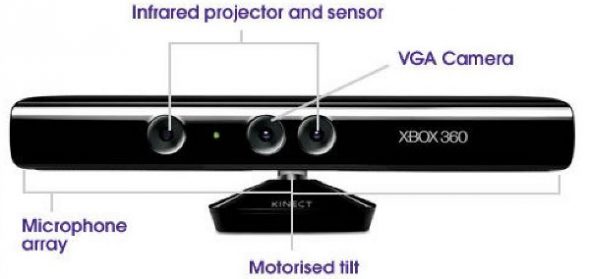
How wonderful life would be if you could control:
- A television without a remote control
- A computer without a keyboard, mouse or touchscreen
- Games without any controller in your hand
Well, all this is possible with the Kinect. Though initially invented for gaming, people have begun using it for different purposes (more on this later).
The Kinect is a motion-sensing device developed by Microsoft for the Xbox 360 video game console. The main idea was to be able to use a gaming console without any kind of controller. The Kinect is packed with an array of sensors and specialised devices to preprocess the information received. Communication between the Kinect and the game console, or Linux, is through a single USB cable.

Its main features include:
- Gesture recognition: It can recognise gestures like hand movements, based on inputs from an RGB camera and depth sensor.
- Speech recognition: It can recognise spoken words and convert them into text, although accuracy strictly depends on the dictionary used. Input is from a microphone array.
The main components are the RGB camera, depth sensor and microphone array. The depth sensor combines an IR laser projector with a monochrome CMOS sensor to get 3D video data. Besides these, there is a motor to tilt the sensor array up and down for the best view of the scene, and an accelerometer to sense position.
Although Kinect has been developed by Microsoft, within a week a FOSS enthusiast developed an open source driver for it. Microsoft denies that the Kinect can be “hacked”. After watching the video developed by the FOSS enthusiast, Microsoft’s Alex Kipman, speaking formally on NPR’s Science Friday, said: “The first thing to talk about is, Kinect was not actually hacked. Hacking would mean that someone got to our algorithms that sit inside of the Xbox and was able to actually use them, which hasn’t happened. Or, it means that you put a device between the sensor and the Xbox for means of cheating, which also has not happened. That’s what we call hacking, and that’s what we have put a ton of work and effort to make sure doesn’t actually occur. What has happened is that someone wrote an open source driver for PCs that essentially opens the USB connection, which we didn’t protect by design, and reads the inputs from the sensor. The sensor, again, as I said earlier, has eyes and ears, and that’s a whole bunch of noise that someone needs to take and turn into signals.”
Well, when we open source users use the work hack, we mean something completely different. But, anyway, that’s another story.
To get the best out of the Kinect, “natural user interface” and “machine learning” are the two terms that must be clear in your mind. Natural user interface (NUI) refers to the close interaction between the user and the computer. It includes controlling the computer by gestures, or the computer recognising the user’s voice/face. Microsoft Surface, multitouch and Kinect are a few examples of NUI.
Machine learning, “ a branch of artificial intelligence, is a scientific discipline concerned with the design and development of algorithms that allow computers to evolve behaviour based on empirical data, such as from sensor data.” (Wikipedia).
Open platforms supporting the Kinect
The OpenKinect community was founded by the developer of the Kinect open source driver. Another organisation, OpenNI, was founded by PrimeSense, Willow Garage, SideKick and ASUS. OpenKinect publishes its code under Apache 2.0 or GPL 2 licenses, while OpenNI publishes its work under different licenses. There are mainly two open platforms or libraries, namely libfreenect and OpenNI. These have been developed for almost the same purpose, and both support various languages like Python, C++, C#, JavaScript, Java JNI, Java JNA and ActionScript.
Some amazing things/projects that can be done with Kinect:
- ROS (Robot Operating System) Kinect is an open source project focused on the integration of the Kinect sensor with ROS. ROS uses both drivers — OpenNI and libfreenect.
- Kinect-controlled computers: Based on user gestures and/or speech recognition, Kinect can control the computer — although no one has done it for Linux yet.
- Scanning of 3D objects: Kinect enables robots to map 3D objects, resulting in detailed and precise models of people.
- Medical applications: Gesture-based control of surgical tools.
- Education: Writing and calculator applications have already been developed using it.
- And there are many more…
In subsequent articles, I plan to cover the installation for libfreenect and some interesting Kinect applications (of course, with source code).





Ah man i want so badly learn how to use Open Source …
I LOVE U
@aseemsood to be honest – old news. Lacking is a 3D gesture projector = kinect+sixth sense